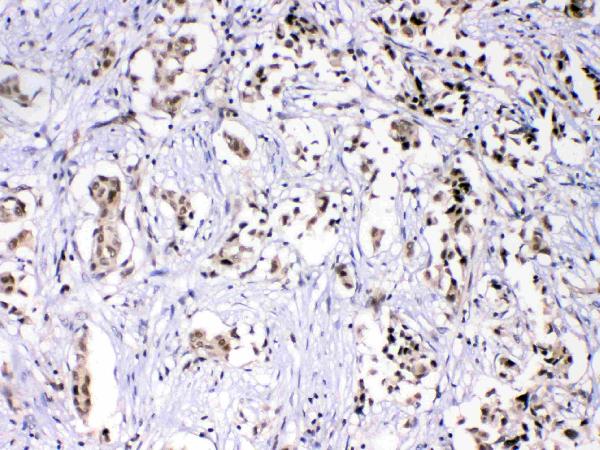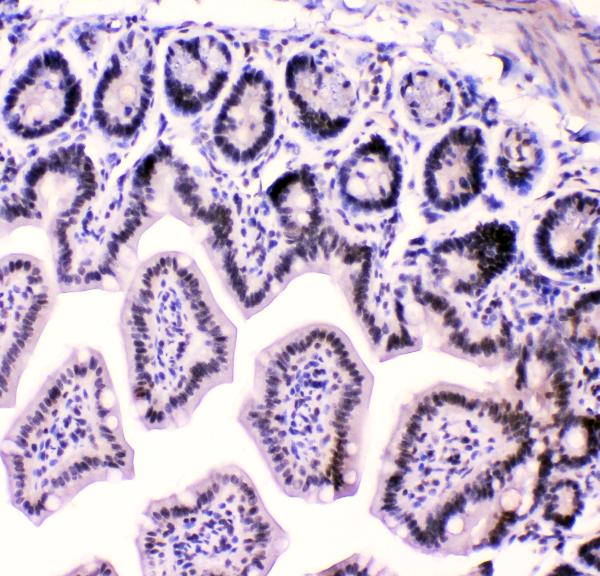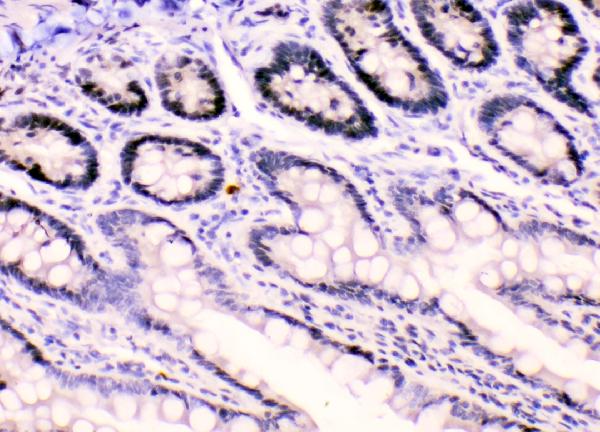Product Info Summary
| SKU: | A05806 |
|---|---|
| Size: | 100 μg/vial |
| Reactive Species: | Human, Mouse, Rat |
| Host: | Rabbit |
| Application: | Flow Cytometry, IF, IHC, IHC-F, ICC, WB |
Customers Who Bought This Also Bought
Product info
Product Name
Anti-HnRNP F/HNRNPF Antibody Picoband®
SKU/Catalog Number
A05806
Size
100 μg/vial
Form
Lyophilized
Description
Boster Bio Anti-HnRNP F/HNRNPF Antibody Picoband® catalog # A05806. Tested in Flow Cytometry, IF, IHC, IHC-F, ICC, WB applications. This antibody reacts with Human, Mouse, Rat. The brand Picoband indicates this is a premium antibody that guarantees superior quality, high affinity, and strong signals with minimal background in Western blot applications. Only our best-performing antibodies are designated as Picoband, ensuring unmatched performance.
Storage & Handling
Store at -20˚C for one year from date of receipt. After reconstitution, at 4˚C for one month. It can also be aliquotted and stored frozen at -20˚C for six months. Avoid repeated freeze-thaw cycles.
Cite This Product
Anti-HnRNP F/HNRNPF Antibody Picoband® (Boster Biological Technology, Pleasanton CA, USA, Catalog # A05806)
Host
Rabbit
Contents
Each vial contains 4mg Trehalose, 0.9mg NaCl, 0.2mg Na2HPO4, 0.05mg NaN3.
Clonality
Polyclonal
Isotype
Rabbit IgG
Immunogen
A synthetic peptide corresponding to a sequence at the N-terminus of human HnRNP F, different from the related mouse and rat sequences by two amino acids.
*Blocking peptide can be purchased. Costs vary based on immunogen length. Contact us for pricing.
Cross-reactivity
No cross-reactivity with other proteins
Reactive Species
A05806 is reactive to HNRNPF in Human, Mouse, Rat
Reconstitution
Add 0.2ml of distilled water will yield a concentration of 500ug/ml.
Observed Molecular Weight
46 kDa
Calculated molecular weight
45672 MW
Background of hnRNP F
Heterogeneous nuclear ribonucleoprotein F is a protein that in humans is encoded by the HNRNPF gene. This gene belongs to the subfamily of ubiquitously expressed heterogeneous nuclear ribonucleoproteins (hnRNPs). The hnRNPs are RNA binding proteins that complex with heterogeneous nuclear RNA (hnRNA). These proteins are associated with pre-mRNAs in the nucleus and regulate alternative splicing, polyadenylation, and other aspects of mRNA metabolism and transport. While all of the hnRNPs are present in the nucleus, some seem to shuttle between the nucleus and the cytoplasm. The hnRNP proteins have distinct nucleic acid binding properties. The protein encoded by this gene has three repeats of quasi-RRM domains that bind to RNAs which have guanosine-rich sequences. This protein is very similar to the family member hnRPH. Multiple alternatively spliced variants, encoding the same protein, have been identified.
Antibody Validation
Boster validates all antibodies on WB, IHC, ICC, Immunofluorescence, and ELISA with known positive control and negative samples to ensure specificity and high affinity, including thorough antibody incubations.
Application & Images
Applications
A05806 is guaranteed for Flow Cytometry, IF, IHC, IHC-F, ICC, WB Boster Guarantee
Assay Dilutions Recommendation
The recommendations below provide a starting point for assay optimization. The actual working concentration varies and should be decided by the user.
Western blot, 0.1-0.5μg/ml, Human, Mouse, Rat
Immunohistochemistry (Paraffin-embedded Section), 0.5-1μg/ml, Human, Mouse, Rat, By Heat
Immunohistochemistry (Frozen Section), 0.5-1μg/ml, Human
Immunocytochemistry/Immunofluorescence, 2μg/ml, Human
Flow Cytometry (Fixed), 1-3μg/1x106 cells, Human
Positive Control
WB: human SKOV3 whole cell, human 293T whole cell, human Hela whole cell, human PANC-1 whole cell, human RT4 whole cell, human K562 whole cell, human U20S whole cell, human PC-3 whole cell, rat liver tissue, rat RH35 whole cell, rat C6 whole cell, mouse liver tissue, mouse SP2/0 whole cell, mouse HEPA1-6 whole cell
IHC: human mammary cancer tissue, human intestinal cancer tissue, mouse intestine tissue, rat intestine tissue
ICC/IF: SKOV-3 cell
FCM: U87 cell
Validation Images & Assay Conditions

Click image to see more details
Figure 1. Western blot analysis of HnRNPF using anti-HnRNPF antibody (A05806).
Electrophoresis was performed on a 5-20% SDS-PAGE gel at 70V (Stacking gel) / 90V (Resolving gel) for 2-3 hours. The sample well of each lane was loaded with 30 ug of sample under reducing conditions.
Lane 1: human SKOV3 whole cell lysates,
Lane 2: human 293T whole cell lysates,
Lane 3: human Hela whole cell lysates,
Lane 4: human PANC-1 whole cell lysates,
Lane 5: human RT4 whole cell lysates,
Lane 6: human K562 whole cell lysates,
Lane 7: human U20S whole cell lysates,
Lane 8: human PC-3 whole cell lysates.
After electrophoresis, proteins were transferred to a nitrocellulose membrane at 150 mA for 50-90 minutes. Blocked the membrane with 5% non-fat milk/TBS for 1.5 hour at RT. The membrane was incubated with rabbit anti-HnRNPF antigen affinity purified polyclonal antibody (Catalog # A05806) at 0.5 μg/mL overnight at 4°C, then washed with TBS-0.1%Tween 3 times with 5 minutes each and probed with a goat anti-rabbit IgG-HRP secondary antibody at a dilution of 1:5000 for 1.5 hour at RT. The signal is developed using an Enhanced Chemiluminescent detection (ECL) kit (Catalog # EK1002) with Tanon 5200 system. A specific band was detected for HnRNPF at approximately 46 kDa. The expected band size for HnRNPF is at 46 kDa.

Click image to see more details
Figure 2. Western blot analysis of HnRNPF using anti-HnRNPF antibody (A05806).
Electrophoresis was performed on a 5-20% SDS-PAGE gel at 70V (Stacking gel) / 90V (Resolving gel) for 2-3 hours. The sample well of each lane was loaded with 30 ug of sample under reducing conditions.
Lane 1: rat liver tissue lysates,
Lane 2: rat RH35 whole cell lysates,
Lane 3: rat C6 whole cell lysates,
Lane 4: mouse liver tissue lysates,
Lane 5: mouse SP2/0 whole cell lysates,
Lane 6: mouse HEPA1-6 whole cell lysates.
After electrophoresis, proteins were transferred to a nitrocellulose membrane at 150 mA for 50-90 minutes. Blocked the membrane with 5% non-fat milk/TBS for 1.5 hour at RT. The membrane was incubated with rabbit anti-HnRNPF antigen affinity purified polyclonal antibody (Catalog # A05806) at 0.5 μg/mL overnight at 4°C, then washed with TBS-0.1%Tween 3 times with 5 minutes each and probed with a goat anti-rabbit IgG-HRP secondary antibody at a dilution of 1:5000 for 1.5 hour at RT. The signal is developed using an Enhanced Chemiluminescent detection (ECL) kit (Catalog # EK1002) with Tanon 5200 system. A specific band was detected for HnRNPF at approximately 46 kDa. The expected band size for HnRNPF is at 46 kDa.

Click image to see more details
Figure 3. IHC analysis of HnRNPF using anti-HnRNPF antibody (A05806).
HnRNPF was detected in paraffin-embedded section of human mammary cancer tissues. Heat mediated antigen retrieval was performed in citrate buffer (pH6, epitope retrieval solution) for 20 mins. The tissue section was blocked with 10% goat serum. The tissue section was then incubated with 1μg/ml rabbit anti-HnRNPF Antibody (A05806) overnight at 4°C. Biotinylated goat anti-rabbit IgG was used as secondary antibody and incubated for 30 minutes at 37°C. The tissue section was developed using Strepavidin-Biotin-Complex (SABC)(Catalog # SA1022) with DAB as the chromogen.

Click image to see more details
Figure 4. IHC analysis of HnRNPF using anti-HnRNPF antibody (A05806).
HnRNPF was detected in paraffin-embedded section of human intestinal cancer tissues. Heat mediated antigen retrieval was performed in citrate buffer (pH6, epitope retrieval solution) for 20 mins. The tissue section was blocked with 10% goat serum. The tissue section was then incubated with 1μg/ml rabbit anti-HnRNPF Antibody (A05806) overnight at 4°C. Biotinylated goat anti-rabbit IgG was used as secondary antibody and incubated for 30 minutes at 37°C. The tissue section was developed using Strepavidin-Biotin-Complex (SABC)(Catalog # SA1022) with DAB as the chromogen.

Click image to see more details
Figure 5. IHC analysis of HnRNPF using anti-HnRNPF antibody (A05806).
HnRNPF was detected in paraffin-embedded section of mouse intestine tissues. Heat mediated antigen retrieval was performed in citrate buffer (pH6, epitope retrieval solution) for 20 mins. The tissue section was blocked with 10% goat serum. The tissue section was then incubated with 1μg/ml rabbit anti-HnRNPF Antibody (A05806) overnight at 4°C. Biotinylated goat anti-rabbit IgG was used as secondary antibody and incubated for 30 minutes at 37°C. The tissue section was developed using Strepavidin-Biotin-Complex (SABC)(Catalog # SA1022) with DAB as the chromogen.

Click image to see more details
Figure 6. IHC analysis of HnRNPF using anti-HnRNPF antibody (A05806).
HnRNPF was detected in paraffin-embedded section of rat intestine tissues. Heat mediated antigen retrieval was performed in citrate buffer (pH6, epitope retrieval solution) for 20 mins. The tissue section was blocked with 10% goat serum. The tissue section was then incubated with 1μg/ml rabbit anti-HnRNPF Antibody (A05806) overnight at 4°C. Biotinylated goat anti-rabbit IgG was used as secondary antibody and incubated for 30 minutes at 37°C. The tissue section was developed using Strepavidin-Biotin-Complex (SABC)(Catalog # SA1022) with DAB as the chromogen.

Click image to see more details
Figure 8. Flow Cytometry analysis of U87 cells using anti-HnRNPF antibody (A05806).
Overlay histogram showing U87 cells stained with A05806 (Blue line). To facilitate intracellular staining, cells were fixed with 4% paraformaldehyde and permeabilized with permeabilization buffer. The cells were blocked with 10% normal goat serum. And then incubated with rabbit anti-HnRNPF Antibody (A05806, 1μg/1x106 cells) for 30 min at 20°C. DyLight®488 conjugated goat anti-rabbit IgG (BA1127, 5-10μg/1x106 cells) was used as secondary antibody for 30 minutes at 20°C. Isotype control antibody (Green line) was rabbit IgG (1μg/1x106) used under the same conditions. Unlabelled sample without incubation with primary antibody and secondary antibody (Red line) was used as a blank control.

Click image to see more details
Figure 7. IF analysis of HnRNPF using anti-HnRNPF antibody (A05806).
HnRNPF was detected in immunocytochemical section of SKOV-3 cells. Enzyme antigen retrieval was performed using IHC enzyme antigen retrieval reagent (AR0022) for 15 mins. The cells were blocked with 10% goat serum. And then incubated with 2μg/mL rabbit anti-HnRNPF Antibody (A05806) overnight at 4°C. DyLight®488 Conjugated Goat Anti-Rabbit IgG (BA1127) was used as secondary antibody at 1:100 dilution and incubated for 30 minutes at 37°C. The section was counterstained with DAPI. Visualize using a fluorescence microscope and filter sets appropriate for the label used.
Protein Target Info & Infographic
Gene/Protein Information For HNRNPF (Source: Uniprot.org, NCBI)
Gene Name
HNRNPF
Full Name
Heterogeneous nuclear ribonucleoprotein F
Weight
45672 MW
Alternative Names
Heterogeneous nuclear ribonucleoprotein F;hnRNP F;Nucleolin-like protein mcs94-1;Heterogeneous nuclear ribonucleoprotein F, N-terminally processed;HNRNPF;HNRPF; HNRNPF HNRPF, OK/SW-cl.23, mcs94-1 heterogeneous nuclear ribonucleoprotein F heterogeneous nuclear ribonucleoprotein F|HnRNP F protein|nucleolin-like protein mcs94-1
*If product is indicated to react with multiple species, protein info is based on the gene entry specified above in "Species".For more info on HNRNPF, check out the HNRNPF Infographic

We have 30,000+ of these available, one for each gene! Check them out.
In this infographic, you will see the following information for HNRNPF: database IDs, superfamily, protein function, synonyms, molecular weight, chromosomal locations, tissues of expression, subcellular locations, post-translational modifications, and related diseases, research areas & pathways. If you want to see more information included, or would like to contribute to it and be acknowledged, please contact [email protected].
Specific Publications For Anti-HnRNP F/HNRNPF Antibody Picoband® (A05806)
Hello CJ!
No publications found for A05806
*Do you have publications using this product? Share with us and receive a reward. Ask us for more details.
Recommended Resources
Here are featured tools and databases that you might find useful.
- Boster's Pathways Library
- Protein Databases
- Bioscience Research Protocol Resources
- Data Processing & Analysis Software
- Photo Editing Software
- Scientific Literature Resources
- Research Paper Management Tools
- Molecular Biology Software
- Primer Design Tools
- Bioinformatics Tools
- Phylogenetic Tree Analysis
Customer Reviews
Have you used Anti-HnRNP F/HNRNPF Antibody Picoband®?
Submit a review and receive an Amazon gift card.
- $30 for a review with an image
0 Reviews For Anti-HnRNP F/HNRNPF Antibody Picoband®
Customer Q&As
Have a question?
Find answers in Q&As, reviews.
Can't find your answer?
Submit your question
5 Customer Q&As for Anti-HnRNP F/HNRNPF Antibody Picoband®
Question
Is this A05806 anti-HnRNP F/HNRNPF antibody reactive to the isotypes of HNRNPF?
Verified Customer
Verified customer
Asked: 2020-01-30
Answer
The immunogen of A05806 anti-HnRNP F/HNRNPF antibody is A synthetic peptide corresponding to a sequence at the N-terminus of human HnRNP F (23-53aa SVEDVQNFLSDCTIHDGAAGVHFIYTREGRQ), different from the related mouse and rat sequences by two amino acids. Could you tell me which isotype you are interested in so I can help see if the immunogen is part of this isotype?
Boster Scientific Support
Answered: 2020-01-30
Question
We are currently using anti-HnRNP F/HNRNPF antibody A05806 for human tissue, and we are content with the IHC-F results. The species of reactivity given in the datasheet says human, mouse, rat. Is it true that the antibody can work on feline tissues as well?
Verified Customer
Verified customer
Asked: 2019-06-27
Answer
The anti-HnRNP F/HNRNPF antibody (A05806) has not been tested for cross reactivity specifically with feline tissues, though there is a good chance of cross reactivity. We have an innovator award program that if you test this antibody and show it works in feline you can get your next antibody for free. Please contact me if I can help you with anything.
Boster Scientific Support
Answered: 2019-06-27
Question
My question regarding product A05806, anti-HnRNP F/HNRNPF antibody. I was wondering if it would be possible to conjugate this antibody with biotin. I would need it to be without BSA or sodium azide. I am planning on using a buffer exchange of sodium azide with PBS only. Would there be problems for me to conjugate the antibody and store it in -20 degrees in small aliquots?
Verified Customer
Verified customer
Asked: 2019-02-05
Answer
We suggest not storing this antibody with PBS buffer only in -20 degrees. If you want to store it in -20 degrees it is best to add some cryoprotectant like glycerol. If you want carrier free A05806 anti-HnRNP F/HNRNPF antibody, we can provide it to you in a special formula with trehalose and/or glycerol. These molecules will not interfere with conjugation chemistry and provide a good level of protection for the antibody from degradation. Please be sure to specify this in your purchase order.
Boster Scientific Support
Answered: 2019-02-05
Question
Would A05806 anti-HnRNP F/HNRNPF antibody work on parafin embedded sections? If so, which fixation method do you recommend we use (PFA, paraformaldehyde, other)?
C. Collins
Verified customer
Asked: 2017-03-24
Answer
You can see on the product datasheet, A05806 anti-HnRNP F/HNRNPF antibody as been tested on WB. It is best to use PFA for fixation because it has better tissue penetration ability. PFA needs to be prepared fresh before use. Long term stored PFA turns into formalin, as the PFA molecules congregate and become formalin.
Boster Scientific Support
Answered: 2017-03-24
Question
I see that the anti-HnRNP F/HNRNPF antibody A05806 works with WB, what is the protocol used to produce the result images on the product page?
T. Williams
Verified customer
Asked: 2015-07-20
Answer
You can find protocols for WB on the "support/technical resources" section of our navigation menu. If you have any further questions, please send an email to [email protected]
Boster Scientific Support
Answered: 2015-07-20




